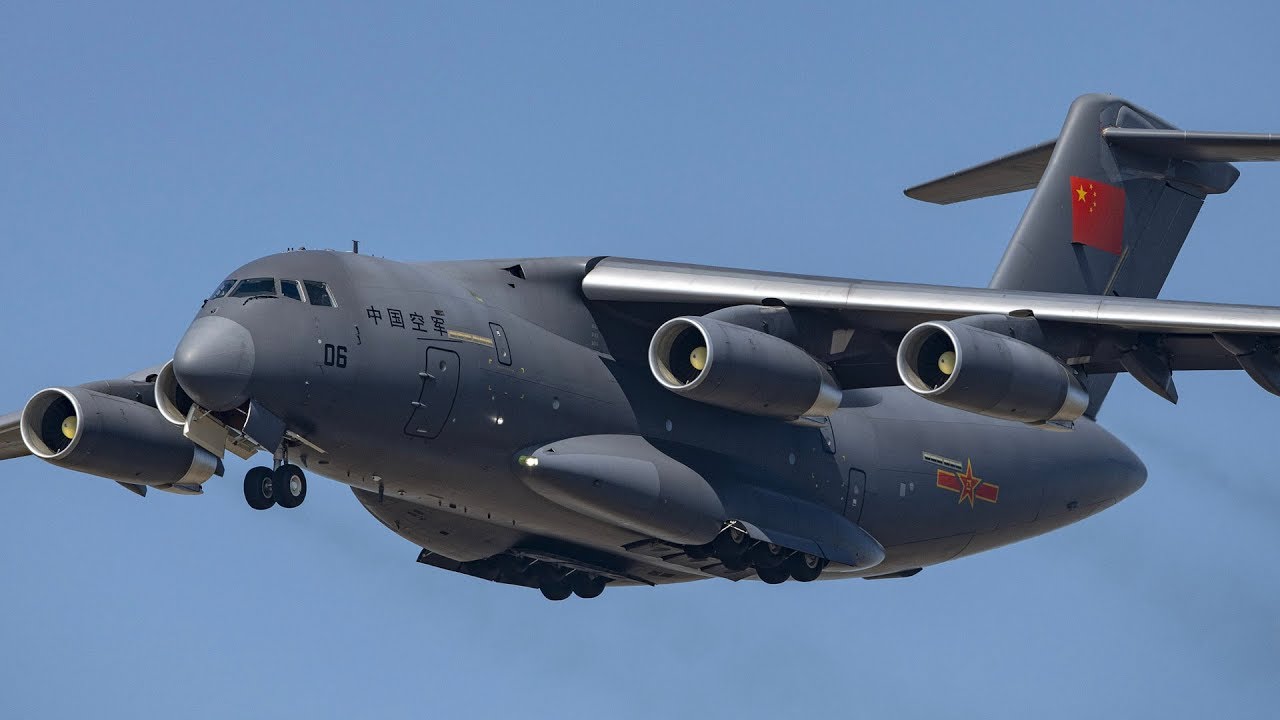A video has surfaced featuring the latest version of China’s Xi’an Y-20 military transport aircraft, the Y-20B, equipped with the homegrown WS-20 engine.
Furthermore, reports suggest this new version may have already entered service with the People’s Liberation Army Air Force (PLAAF).
The latest video depicting the new Y-20B aircraft seems to have been featured on the Military Report program, produced by the state-run CCTV-7 television channel dedicated to showing PLA’s content.
The video shows a Y-20B loaded with cargo that is later air-dropped under parachutes.
Experts suggest the Y-20B may have been inducted into the service by the PLAAF. However, the aircraft in the video lacks serial numbers, indicating it could be a pre-series example used for trials.
China's Y-20B with the WS-20 high-bypass engine
Now officially confirmed to be in service with the Chinese air force.
In terms of engine variety and sophistication, China's aerospace engine industry for the most part have entered top tier status, previously occupied by the US pic.twitter.com/ItoTNSBL75
— Zhao DaShuai 无条件爱国?? (@zhao_dashuai) April 6, 2023
That said, it is also possible that the serial number or any such identification markings may have been obscured for the type’s public appearance.
The Y-20B & WS-20 High-Bypass Turbofan Engine
The Y-20B, powered by the domestically produced WS-20 high-bypass turbofan engine, is considered a significant improvement over the Y-20A, which uses the Russian-made Soloviev D-30KP-2 engines.
The WS-20 is expected to produce a thrust of around 31,000 pounds (137.89 kN), compared to 26,450 pounds (117.65kN) produced by the D-30KP-2, which powers the original Y-20A, which first entered operational service in 2016.
The D-30KP-2 is a low-bypass engine, meaning less air flows around the engine (bypass air) than through the engine’s core. Low-bypass engines cannot produce the same level of thrust as high-bypass units of similar size and are much less efficient.
According to these images, the Y-20B seems to be officially unveiled! ?
But since there is not yet a serial number applied, I think these are not yet handed over officially. ?
(Images via @军I名 from Weibo) pic.twitter.com/Y94Y0kNca7
— @Rupprecht_A (@RupprechtDeino) April 6, 2023
The Y-20 transport aircraft represents a massive capability for the PLAAF, as is evident from the considerable resources allocated by China to its development.
Before the Y-20, the PLAAF’s most effective transport aircraft was the Russian-made Il-76 Candid, also equipped with the D-30KP-2. However, China struggled to acquire these in sufficient numbers, with only around 20 in use.
As EurAsian Times reported earlier, the Y-20 heavy transport aircraft is said to have been developed using designs stolen from Boeing. Also, the Y-20 bears a massive resemblance to the US military’s Boeing C-17 Globemaster III.

Interestingly, in 2009, a former Boeing employee was reportedly convicted of selling C-17 technical details to China while the Y-20 was still in early development.
What is also noteworthy is the production rate of the Y-20, with examples of the type coming off the line at Xi’an at an extraordinary rate.
The importance of Y-20 for the PLAAF is also reflected in the pace at which the re-engining program for the aircraft type seems to have progressed.
The first evidence of a Y-20, equipped with a WS-20 engine, emerged in late 2020 when images surfaced in which the aircraft appeared to conduct a test flight at Xi’an-Yanliang Air Base.
However, the WS-20 was not expected to become available in 2024, and even then, only in limited production.

However, going by the recent video and claims of Y-20B having become operational with the PLAAF, it seems there is at least a good amount of confidence that the engine will be available in the required numbers.
This supposed acceleration in the development of the WS-20 could either be because of the program’s higher priority or because the engine is facing fewer developmental problems than expected.
As EurAsian Times discussed earlier, China has long struggled to master engine technology which requires deep expertise across various disciplines such as combustion, fluid dynamics, materials, control theory, etc.
For instance, China produced the WS-10 Taihang turbofan engine as part of its drive to replace the Russian-made AL-31F turbofans in its fighter jets completely.
However, the WS-10 engines faced several quality-control issues that hindered their mass production.
Importance Of Y-20 For China’s Aerial Power
The Y-20 aircraft enables the PLA to deploy and sustain forces over much greater distances, allowing China to realize a true global power status.
For instance, in April 2022, China undertook an unprecedented overseas mission, as part of which six Y-20 heavy transport aircraft flew simultaneously to Serbia, surprising the flight trackers and aviation watchers.
These Y-20s carried FK-3 surface-to-air missiles to Serbia, seen as China demonstrating its military might in Europe amid the ongoing Ukraine crisis.
According to Fu Qianshao, a Chinese military aviation expert, the operation demonstrated a considerable advance in the PLA Air Force’s long-range strategic transport capabilities and the heavy transport aircraft’s intercontinental logistics support and maintenance capabilities.
The Y-20 can carry transport cargo as big and heavy as the Type 99 main battle tank. Introducing WS-20 engines will only increase the aircraft’s ability to transport large amounts of equipment and supplies over long distances.
As of present, the original D-30KP-2 engines allow the Y-20 to carry a maximum payload of 132,000 pounds (nearly 60 tons), which is way short of the capacity of the US Air Force’s (USAF’s) C-17, which has a payload capacity of 170,900 pounds (nearly 78 tons).
So, it remains to be seen to what degree the WS-120 can close this gap for the Y-20.
The improved WS-20 engines are also expected to bridge other gaps in the PLAAF’s capabilities, such as tanker capacity.
Currently, PLAAF’S aerial refueling tank capacity is centered mainly around three second-hand examples of the Soviet-era Il-78 Midas and ten tanker conversions of the H-6 Badger bomber.
The Y-20U aerial refueling tanker has reportedly become operational with D-30KP-2 engines and should be an obvious candidate to receive WS-20s.
PLAAF officially announces the induction of Y-20U tanker and releases the footage of Y-20U refueling J-16. pic.twitter.com/AKMJFoshpp
— dafeng cao (@dafengcao) July 31, 2022
As the PLAAF increasingly demonstrates its strength in the South China Sea and the East China Sea, as well as in the Taiwan Strait, tanker support is essential. Therefore, improved payload capacity and efficiency of a re-engined version would certainly help.
Additionally, there have been speculations of a new airborne early warning and control (AEW&C) platform based on the Y-20 airframe, possibly designated as KJ-3000. However, there is nothing conclusive about this aircraft.
This is an interesting model: A white fairing can be seen installed on top and under the fuselage and some claim, the landing gear / gear fairing was lengthened too … ?
Even if IMO it is not the rumoured KJ-3000 AEW, a variant for EW/ELINT/SIGINT could be a possibility. pic.twitter.com/RTsB8vi0ZO
— @Rupprecht_A (@RupprechtDeino) December 20, 2022
There have been unconfirmed suggestions that a wind tunnel model of the KJ-3000 has been tested. An image of a model surfaced in December 2022, showing a Y-20B-based design.
However, this model does not have the traditional rotodome for the main radar antenna. Instead, it has a series of large radomes above and below the forward fuselage, as well as smaller fairings on the leading edges of the sponsons.
Therefore, it seems that the model may relate to an airborne command post or long-range communications aircraft, possibly to operate with the PLA Navy’s ballistic missile submarines (SSBNs), similar to the US Navy’s E-6B Mercury.
- Contact the author at tanmaykadam700@gmail.com
- Follow EurAsian Times on Google News




